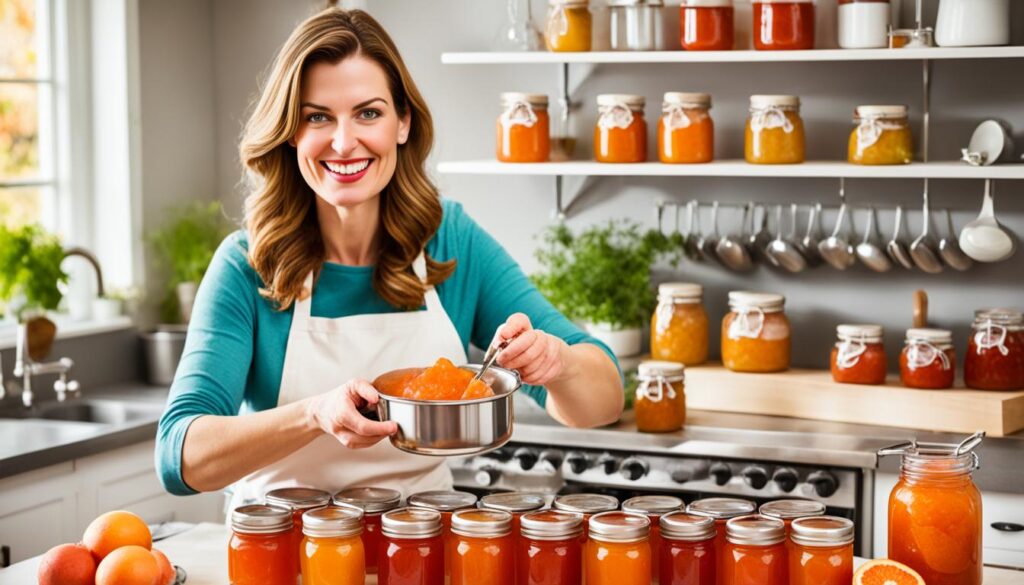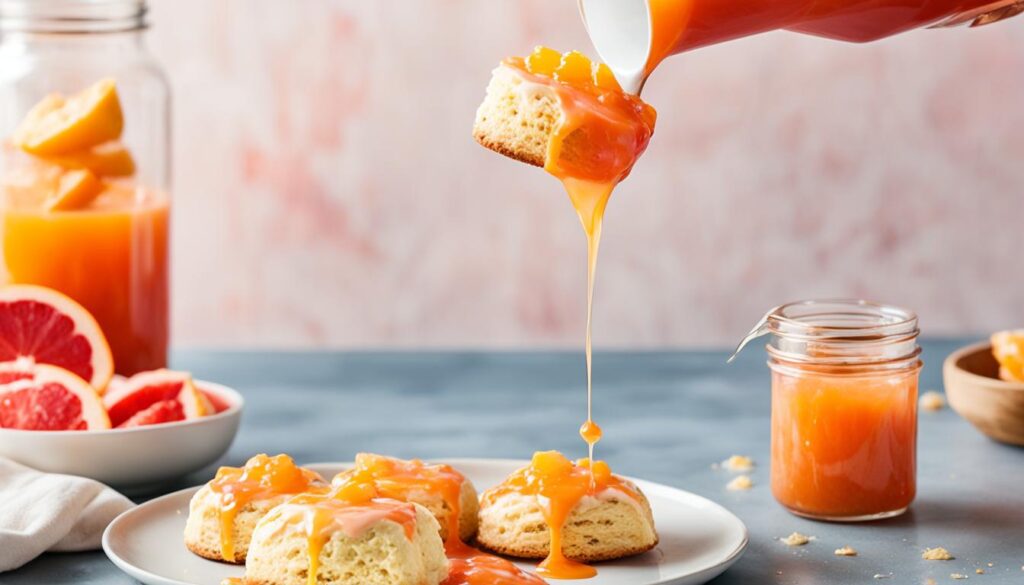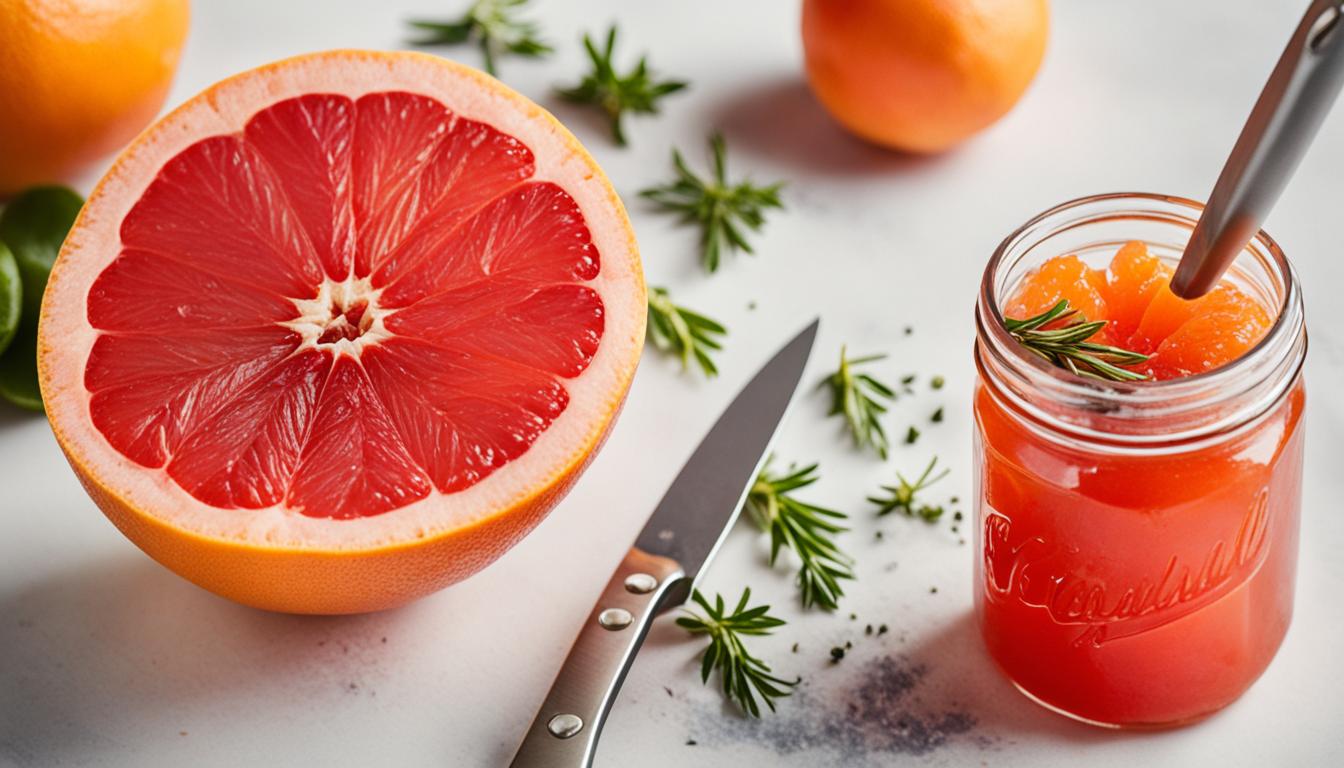Welcome to our delightful homemade fresh grapefruit marmalade recipe! If you love the idea of creating your own condiments using seasonal produce, you’re in for a treat. This soft-set grapefruit marmalade is made with just four simple ingredients and is the perfect addition to your breakfast table. Passed down through generations, this family heirloom recipe produces a bright and tangy marmalade that is incredibly easy to make. Let’s dive into the citrusy goodness and explore the step-by-step instructions.
But first, let’s talk about the benefits of homemade grapefruit preserves. By making your own marmalade, you have full control over the ingredients, ensuring you enjoy the freshest flavors without any artificial additives. Plus, there’s something truly satisfying about preserving the bountiful flavors of seasonal fruit to enjoy throughout the year.
Our citrus marmalade instructions are designed to help you create a delightful balance of sweet and tangy flavors, with a soft-set texture that spreads beautifully on your morning toast. But don’t limit yourself there! This versatile marmalade can also be used as a glaze for meat dishes or as an ingredient to elevate a range of recipes.
Are you ready to embark on a homemade marmalade-making adventure? Let’s gather our ingredients and get started!
Ingredients and Preparation
In order to create this delicious homemade grapefruit marmalade, we will need a few key ingredients: grapefruit, lemon, sugar, and water. For the best flavor, it is recommended to use fresh and organic fruit that is free of wax coating. Here’s a step-by-step guide on preparing this delightful homemade jelly recipe:
- Start by cutting the grapefruit and lemon into quarters and then finely slice them. Be sure to remove any seeds.
- Next, place the sliced fruit into a bowl and add water. Allow the fruit to soak overnight, as this will help soften the peel and release the natural pectin.
- After the overnight soak, transfer the fruit and water mixture to a saucepan and bring it to a boil. Reduce the heat and let it simmer for around 45 minutes or until the fruit is tender.
- Once the fruit is tender, add sugar to the saucepan and continue to cook until the sugar has dissolved completely.
- Now it’s time to test the marmalade for the setting point. You can do this by placing a small amount of the marmalade onto a chilled plate and letting it cool for a minute. Push the marmalade with your finger, and if it wrinkles, it has reached the desired setting point. If not, continue cooking and testing until it does.
- Once the marmalade has reached the desired setting point, remove it from the heat and let it cool for a few minutes.
- Pour the marmalade into sterilized jars, ensuring they are filled to the top. This will help create a proper seal.
- Seal the jars tightly and let them cool completely before storing them in a cool, dark place.
By following these simple steps, you’ll be able to create your own homemade grapefruit marmalade that is bursting with citrusy goodness. The tangy flavor of the grapefruit combined with the zesty lemon creates a delightful balance of sweet and sour. Now, let’s move on to some helpful tips and frequently asked questions.
| Ingredients: | Preparation: |
|---|---|
| Grapefruit | Cut into quarters and finely slice |
| Lemon | Cut into quarters and finely slice |
| Sugar | Add to the cooked fruit and dissolve completely |
| Water | Soak the fruit overnight, then cook with the fruit |
Click on the image to view a visual representation of the homemade grapefruit marmalade recipe.
Tips and FAQs
When it comes to making homemade preserves, there are a few tips and frequently asked questions that can help ensure success. Here are some key points to keep in mind:
Traditional Canning Method
The traditional canning method is a tried and true way to preserve seasonal fruit. It involves sterilizing jars, filling them with the preserves, and sealing them properly to create a vacuum seal. This method helps to extend the shelf life of the preserves, allowing you to enjoy the flavors of seasonal fruit all year round.
Preserves for Toast and Desserts
Fruit preserves, like this fresh grapefruit marmalade, are perfect for spreading on toast or using as a topping for desserts. The tangy and sweet flavors add a burst of freshness to any dish. Whether you prefer a simple breakfast of toast and marmalade or want to elevate your desserts with a fruity twist, preserves are a versatile addition to your pantry.
Easy Fruit Preserves
Making fruit preserves at home can be surprisingly easy. With just a few simple ingredients and some basic cooking techniques, you can create delicious preserves that rival store-bought varieties. This grapefruit marmalade recipe is a great starting point for beginners, as it doesn’t require extensive canning knowledge or specialized equipment. It’s a rewarding and enjoyable process that allows you to customize flavors and experiment with different fruits.
Best Grapefruit Jam Recipe
If you’re looking for the best grapefruit jam recipe, look no further. This homemade grapefruit marmalade is bursting with citrus flavor and made with fresh, organic grapefruits. By using grapefruits without wax coating, you ensure a natural and pure taste. The recipe combines the sweetness of sugar with the tanginess of grapefruit, resulting in a perfectly balanced jam.
Preserves Without Wax Coating
| Benefits of Preserves Without Wax Coating | Drawbacks of Preserves Without Wax Coating |
|---|---|
| 1. More natural and pure taste | 1. Shorter shelf life without wax coating |
| 2. No unnecessary additives | 2. Fruit may require extra cleaning |
| 3. Enhanced texture and appearance | 3. Fruit may be more prone to bruising |
Using fruit without wax coating in your preserves ensures a more natural and pure taste. It eliminates unnecessary additives and allows the true flavors of the fruit to shine through. However, it’s important to note that preserves made with fruit without wax coating may have a slightly shorter shelf life compared to those made with wax-coated fruit. Additionally, extra cleaning of the fruit may be required to remove any dirt or residue. While the lack of wax coating enhances the texture and appearance of the preserves, the fruit may be more prone to bruising.

Serving Suggestions and Variations
Grapefruit marmalade is not just limited to breakfast toast. It can be used in a variety of ways to add flavor and sweetness to savory dishes and desserts. Here are some creative and delicious ways to incorporate grapefruit marmalade into your culinary repertoire:
1. Grapefruit Marmalade Glaze
Use grapefruit marmalade to create a tangy glaze for chicken drumsticks. Simply brush the marmalade onto the drumsticks before baking or grilling for a sticky and flavorful glaze that pairs perfectly with the tender meat.
2. Sauce for Pork Tenderloin
Elevate your pork tenderloin by glazing it with grapefruit marmalade. The citrusy notes of the marmalade complement the savory flavors of the pork, creating a delicious balance of sweet and tangy.
3. Glaze for Christmas Ham
Bring a unique twist to your Christmas feast by using grapefruit marmalade as a glaze for your holiday ham. The bright citrus flavors will add a refreshing element to the rich and smoky ham.
4. Marmalade Marinade for Chicken
Marinate chicken in grapefruit marmalade before grilling or baking to infuse it with a delightful citrusy flavor. The natural acidity of the grapefruit adds a tenderizing effect to the chicken, resulting in juicy and flavorful meat.
5. Crostini with Goat Cheese and Prosciutto
Spread toasted baguette slices with a layer of creamy goat cheese, top with a slice of prosciutto, and finish with a dollop of grapefruit marmalade. The combination of salty prosciutto, tangy goat cheese, and sweet marmalade creates an irresistible bite-sized appetizer.
6. Lemon Cake Glaze
Give your lemon cake a citrusy upgrade by drizzling grapefruit marmalade glaze over the top. The vibrant flavors of the marmalade will enhance the zesty lemon notes and add a burst of fruity sweetness.
7. Baked Brie Topping
Elevate a wheel of baked brie by topping it with a generous spoonful of grapefruit marmalade. The warm, gooey cheese pairs perfectly with the bright and tangy flavors of the marmalade, creating a delectable appetizer or dessert.

With these versatile serving suggestions and variations, grapefruit marmalade can transform ordinary dishes into extraordinary culinary creations. Experiment with different flavor combinations and let your creativity soar!
Storage and Shelf Life
Proper storage is crucial for preserving the homemade marmalade and ensuring its quality and safety. To store the marmalade, it is recommended to use sterilized jars and lids, as this helps maintain the freshness and flavor of the preserves. You can easily sterilize the jars by washing them thoroughly in hot soapy water and then preheating them in the oven. It’s also important to remember that homemade marmalade should be stored in a cool, dark place to preserve its taste and texture.
When prepared correctly, homemade marmalade can have a shelf life of up to 12 months. To achieve this, ensure that the marmalade is cooked to the correct setting point during the preparation process. This will help preserve the marmalade for a longer period. Once you open a jar of marmalade, refrigeration is not necessary. However, if you prefer to extend its shelf life, you can store the opened jar in the refrigerator.
For long-term storage and to keep the homemade marmalade shelf-stable, it is essential to follow proper canning methods. This includes using sterilized jars, ensuring a proper seal, and processing the jars in a boiling water bath. By following these guidelines, you can enjoy your homemade preserves for months to come.
